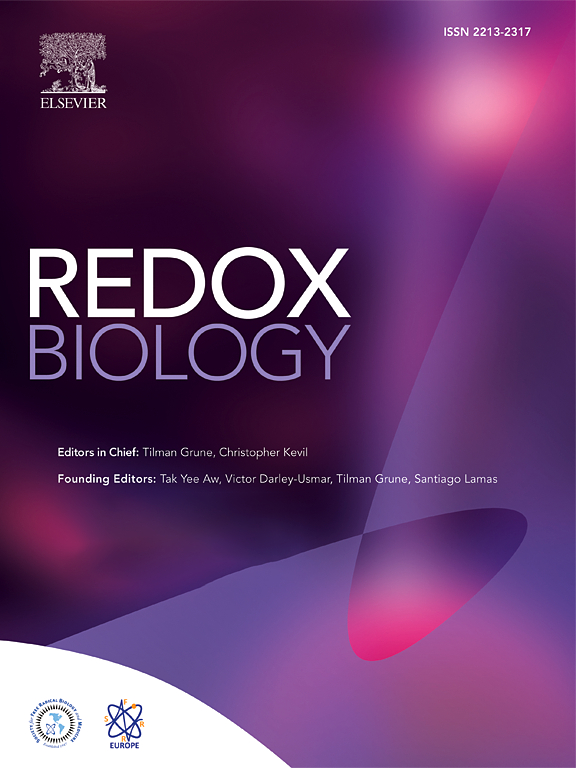EMAP-II from macrophage-derived extracellular vesicles drives neutrophil extracellular traps formation via PI3K/AKT/mtROS in lung ischemia/reperfusion injury
IF 10.7
1区 生物学
Q1 BIOCHEMISTRY & MOLECULAR BIOLOGY
引用次数: 0
Abstract
Lung ischemia/reperfusion injury (LIRI) is a significant complication following lung transplantation driven by neutrophil extracellular traps (NETs) associated with mitochondrial oxidative stress. However, the intercellular signaling mechanisms mediating oxidative stress remain unresolved. Here, we elucidated a mitochondrial reactive oxygen species (mtROS) amplification mechanism driven by extracellular vesicles (EVs). In this mechanism, EVs derived from oxygen-glucose deprivation/reperfusion (OGD/R)-activated macrophages transferred endothelial monocyte-activating polypeptide-II (EMAP-II) to neutrophils, suppressed PI3K/AKT signaling, and thereby induced mitochondrial oxidative stress that drove pathological NETs formation. Proteomic profiling identified EMAP-II as a key signaling molecule enriched in EVs secreted by OGD/R-activated macrophages. Pharmacological inhibition of mtROS or AKT activation abolished NETs formation, confirming the PI3K/AKT/mtROS as the central redox-sensitive pathway. Crucially, shRNA-mediated EMAP-II knockdown in macrophages abolished the ability of OGD/R-EVs to induce mtROS and NETs formation, mitigating pulmonary inflammation and tissue injury in mice. This study establishes EMAP-II from macrophage-derived EVs as transcellular drivers of neutrophil mitochondrial oxidative stress. We propose EMAP-II blockade as a therapeutic strategy to disrupt the pathogenic cascade in LIRI, wherein macrophage-derived EVs trigger NETs formation through PI3K/AKT/mtROS.
巨噬细胞来源的细胞外囊泡EMAP-II在肺缺血/再灌注损伤中通过PI3K/AKT/mtROS驱动中性粒细胞胞外陷阱形成
肺缺血/再灌注损伤(LIRI)是由线粒体氧化应激相关的中性粒细胞胞外陷阱(NETs)驱动的肺移植后的一个重要并发症。然而,细胞间信号机制介导氧化应激仍未解决。在这里,我们阐明了由细胞外囊泡(EVs)驱动的线粒体活性氧(mtROS)扩增机制。在这个机制中,氧葡萄糖剥夺/再灌注(OGD/R)激活的巨噬细胞产生的ev将内皮单核细胞活化多肽- ii (EMAP-II)转移到中性粒细胞,抑制PI3K/AKT信号,从而诱导线粒体氧化应激,驱动病理性NETs形成。蛋白质组学分析发现,EMAP-II是OGD/ r活化巨噬细胞分泌的EVs中富集的关键信号分子。药理抑制mtROS或激活AKT可消除NETs的形成,证实PI3K/AKT/mtROS是中枢氧化还原敏感通路。至关重要的是,shrna介导的巨噬细胞EMAP-II敲低可消除OGD/ r - ev诱导mtROS和NETs形成的能力,从而减轻小鼠肺部炎症和组织损伤。本研究证实巨噬细胞来源的ev中的EMAP-II是中性粒细胞线粒体氧化应激的跨细胞驱动因子。我们提出EMAP-II阻断作为一种治疗策略来破坏LIRI的致病级联反应,其中巨噬细胞来源的EVs通过PI3K/AKT/mtROS触发NETs形成。
本文章由计算机程序翻译,如有差异,请以英文原文为准。
求助全文
约1分钟内获得全文
求助全文
来源期刊

Redox Biology
BIOCHEMISTRY & MOLECULAR BIOLOGY-
CiteScore
19.90
自引率
3.50%
发文量
318
审稿时长
25 days
期刊介绍:
Redox Biology is the official journal of the Society for Redox Biology and Medicine and the Society for Free Radical Research-Europe. It is also affiliated with the International Society for Free Radical Research (SFRRI). This journal serves as a platform for publishing pioneering research, innovative methods, and comprehensive review articles in the field of redox biology, encompassing both health and disease.
Redox Biology welcomes various forms of contributions, including research articles (short or full communications), methods, mini-reviews, and commentaries. Through its diverse range of published content, Redox Biology aims to foster advancements and insights in the understanding of redox biology and its implications.
 求助内容:
求助内容: 应助结果提醒方式:
应助结果提醒方式:


